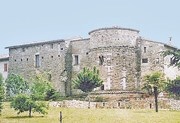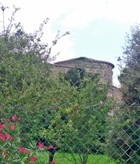


This Benedictine abbey, at Passaggio, some 3 km to the north east of Bettona, is mentioned in a document of 1018 in the episcopal archives of Assisi, in which the Marchese Ranieri recognised the rights of Bishop Giorgio of Assisi over the “Monasterium Sancti Crispolti” and its possessions. According to tradition, it was built on the site of the martyrdom of St Crispolitus, and seems to have re-used material from Roman buildings on the site.
In 1238, Pope Gregory IX transferred the abbey to Santa Maria di Farneto (without prejudice to the rights of the bishops of Assisi), in order to effect its reform. In 1239, he allowed the Commune of Bettona to acquire the abandoned nunnery of Santa Caterina, which belonged to the abbey, in order to provide a place where friars from the new Franciscan Order could settle within the walls of Bettona.
The abbey was placed under the supervision of the Templars for about a decade from ca. 1255, in another attempt to effect its reform.
In 1265, the monks moved the relics of St Crispoltus to a new church dedicated as San Crispolto that they built within the city walls of Bettona. The Franciscan, Bishop Nicolò da Calvi of Assisi, who had rights over the abbey, placed Bettona under interdict, and an invasion by Assisi seemed imminent. Both sides appealed for aid to Perugia, and it was through the good offices of the Perugians and of Cardinal Giacomo Savelli (the future Pope Honorius IV), that a compromise was reached: the relics remained in San Crispolto, but the Benedictines transferred this church to the Franciscans.
In 1352, the campanile destroyed during the war between Bettona and Perugia.
In 1463, the abbey passed in commendam to Bishop Carlo de Nepis of Assisi.





